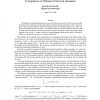Free Online Productivity Tools
i2Speak
i2Symbol
i2OCR
iTex2Img
iWeb2Print
iWeb2Shot
i2Type
iPdf2Split
iPdf2Merge
i2Bopomofo
i2Arabic
i2Style
i2Image
i2PDF
iLatex2Rtf
Sci2ools
APPML
2007
2007
Comparison of distances between measures
The problem of optimal transportation between a set of sources and a set of wells has become recently the object of new mathematical models generalizing the Monge-Kantorovich problem. These models are more realistic as they predict the observed branching structure of communication networks. They also define new distances between measures. The question arises of how these distances compare to the classical Wasserstein distance obtained by the Monge-Kantorovich problem. In this paper we show sharp inequalities between the dα distance induced by branching transport paths and the classical Wasserstein distance over probability measures in a compact domain of Rm . The problem of the optimal mass transportation was introduced by Monge in the 18th century. Kantorovich gave it a first rigorous mathematical treatment. In the Monge-Kantorovich model, two probability measures µ+ and µ− (the source and target mass distributions) are given. Each particle of µ+ travels on a straight line se...
| Added | 08 Dec 2010 |
| Updated | 08 Dec 2010 |
| Type | Journal |
| Year | 2007 |
| Where | APPML |
| Authors | Jean-Michel Morel, Filippo Santambrogio |
Comments (0)

